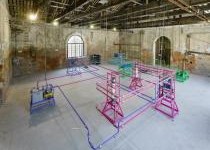Singular Pluralities
A work of art attains a multitude of meaning in relation to the possibilities of approaching itself from various angles and viewpoints. In other words, a work or art becomes plural through the multiple dimensions of meaning spheres it tackles along. In this line of thought, such a piece addresses more than one issue at a time or embraces thematization and production of diverse action/response.
The ‘plurality’ of an artwork sources not only from the theme of the piece, the way the piece foretells its issue, the encounter of its audience, but also its position beyond the content-body, intention-encounter dichotomies. Moreover, the multitude of a piece lies on the expansion of the socio-spatial dialectic of the piece, where the social relations in production are both space forming and space contingent.
Ayse Erkmen’s practice proliferates the notion of socio-spatial dialectic, in a way in which her pieces not only reclaim a site (=the site of the artwork), a place within a place (the venue the piece takes place) while juxtaposing the two significant concepts of classical and contemporary aspects of sculpture: to be surrounded by and to surround, respectively. Moreover, Erkmen furthers the condition of ‘surround’ to the triggering of the liminal space between the work of art and the subjectivity of its audience (J, K & H, 2010; Iki Kardes, 2007).
Ayse Erkmen’s body of work can be defined as spatialisation of the sculptural whilst positing beyond the medium of sculpture; thus can be visited through various subject-matter: contemporary approaches to the notion of sculpture; the here-and-nowness of the work of art; the potentiality of a place; the authenticity principle of a work of art (-though Erkmen breaks the prerequisites of the principle through her act of ‘borrowing’); the ‘becoming place’ of an artwork; the possessive-submissive conditions of cities at large…
Plan B, 2011 is a site-specific installation that of which has been specially commissioned by curator Fulya Erdemci for the Turkish Pavillion of the 54th International Venice Biennial. As a special commission, Plan B exceeds the margins of an installation as a functioning water treatment plant, placed in Arsenale’s only room with a window looking onto the Canals of Venice within a choreographed entanglement of relations between its objects (the engines and the pipes). Water, that of which takes its significance in Erkmen’s various works, also finds its place when Erkmen is commissioned for a new piece in Venice. The condition of Venice as a city of canals, that of which is surrounded by water, rather than divided, or surrounding, influences Erkmen in a way in which she decides to reflect on the condition of water and its substantial position – not only geographically but also socially. With the technical support from the Berkefeld Company, the water treatment plant is reproduced in the light of Erkmen’s intervention. Hence the engines are placed far from one another whilst their function are distinguished with the extended pipes carrying various pantone colours (-which appears as another leitmotiv in Erkmen’s body of work). The water treatment plant sources its water from the sea, filters and clarifies its salt and minerals to the stage that it becomes drinkable supply and returns back to where it has sourced. The subject of the piece, water, circulates in the space, invisibly while the constellation of engines and pipes mark the place of the work. Hence the audience is left to imagine the processes in which water is going through while experiencing the mapped place of the ‘exhibition room’. Plan B, through its physical and functional means, redefines, modifies, transforms the place of the exhibition, which solely rests upon placing works of art on display. Moreover, its futile utilitarian function of treating water stakes its sculptural formation, its visual presentation while surrounding its audience in the sonic space of the engines. Erkmen, constructs a system of relations and more significantly makes it visible through experience of an audience (as a witness and as a visitor).
Erkmen, with each and every intervention she realises in spaces, redefines space through social interrelations and poetics, while producing the place with and within its audience, making the possible use/function/socio-spatial dialectic of space, visible.

